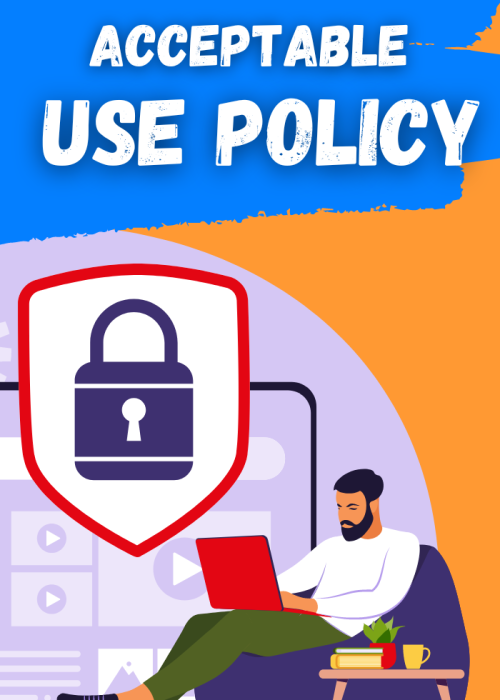Acceptable Use Policy
Generator
With our acceptable use policy generator, you can quickly create a unique acceptable use policy for your website or app. In only a few minutes, you can FOR FREE protect your company and let your users know what the rules are!




Designed for All Businesses
Our policy cater to all businesses, including ecommerce sites and Software-as-a-Service (SaaS) platforms,
Comprehensive
Our Acceptable Use Policy includes common rules such as prohibiting harassment and unauthorized access, while also allowing for custom rules tailored to specific user conduct, intellectual property rights, community guidelines, and privacy and data protection.
Simple to Use
How Does Our Acceptable Use Policy
Generator Work?
Just follow these simple steps to get a custom, acceptable use policy
for your business, software, site, or app.

What Will Be Included in Your Acceptable Use Policy
A default list of generally acceptable and inappropriate uses of a website or mobile application will be included in the acceptable use policy we prepare for you. These guidelines prevent abuse of your platform and protect your company from lawsuits.
A preset list of user-generated content that cannot be posted, transferred, or uploaded to your website or mobile application will be included in our acceptable use policy generator.
When a user transgresses your policy, our generator will outline potential measures you might take and provide you with justification for doing so.
You might not be able to keep an eye on everything that users post on your site. The users will have a mechanism to report any inappropriate user-generated content thanks to your acceptable use policy.
Using our generator, you can add the following extra guidelines to your acceptable use policy:
- Include the rules for your group or forum.
- Describe the methods you employ to keep an eye on user-generated content.
- If users can sell things on your site, specify what they are not allowed to sell.
- If you provide subscription services, specify the actions consumers must not take in order to use your subscription service.
Although your acceptable use policy can be utilised independently, it works best when it is used in conjunction with your Terms of Service. You can use Abhedit to create a Terms of Service document if your product lacks one.
Benefits from using our Acceptable Use Policy
Acceptable Use Policy Generator FAQ
The Acceptable Use Policy is like a superhero with the power to keep everyone in check. It serves as a rulebook for proper behavior and conduct in the digital world, ensuring that we all play nice and stay safe. With acceptable Use Policy at its core, this policy sets clear boundaries on what's allowed and what's not, protecting us from online threats while fostering a sense of community among users.
An Acceptable Use Policy is a set of rules and guidelines that outline the acceptable behaviors and activities for users of a website or app. It defines the terms and conditions for using the service and sets expectations for user conduct.
An AUP is essential for maintaining a safe and productive environment for users and protecting the interests of the website or app owner. It helps prevent misuse, abuse, and violations of laws, regulations, or ethical standards. It also clarifies what actions may result in consequences or account termination.
An AUP should cover various aspects, including but not limited to:
- Prohibited activities: Clearly state actions that are not allowed, such as harassment, hacking, spamming, or uploading illegal content.
- User responsibilities: Outline the obligations of users to follow applicable laws, respect others’ rights, and protect the security and integrity of the service.
- Privacy and data protection: Explain how user information is collected, stored, and used, along with any necessary disclaimers or consent requirements.
- Intellectual property: Clarify the rules regarding copyrighted materials, trademarks, and the unauthorized use or distribution of others’ content.
- Consequences of violations: Describe the potential penalties for non-compliance, such as warnings, suspensions, or account terminations.
- Reporting mechanisms: Provide information on how users can report violations or concerns to the website or app administrators.
An AUP should be easily accessible and prominently displayed on the website or app. It is common to include it as a separate page with a link in the footer or as part of the registration or account creation process. Users may be required to acknowledge and accept the AUP before using the service.
Yes, an AUP can be modified as needed. However, any changes should be communicated to users in advance and prominently displayed on the website or app. Users should be given the opportunity to review and accept the updated AUP or discontinue using the service.
The AUP applies to all users who access and use the website or app, including customers, visitors, or any other individuals who interact with the service. It sets the guidelines for acceptable behavior for anyone utilizing the platform.
The AUP should be easily accessible to users. It is typically provided as a separate page on the website or app, and a link to the AUP is often included in the footer or navigation menu. Additionally, during the registration or account creation process, users may be required to explicitly acknowledge and accept the AUP.
The consequences for AUP violations can vary depending on the severity of the violation and the discretion of the website or app owner. Penalties may include warnings, temporary suspensions, permanent account termination, or legal action if necessary. The AUP should clearly outline the potential consequences of non-compliance.
The AUP should provide clear instructions on how users can report violations or concerns. This may include providing a dedicated email address, an online reporting form, or a designated contact person. Users should be encouraged to report violations promptly to enable the platform to take appropriate action.
Generally, users have the right to dispute AUP violations. The AUP should outline the process for disputing violations, including any relevant contact information or steps to follow. Resolving disputes may involve providing evidence or explanations to contest the violation. Fair and transparent procedures should be in place to handle such disputes.